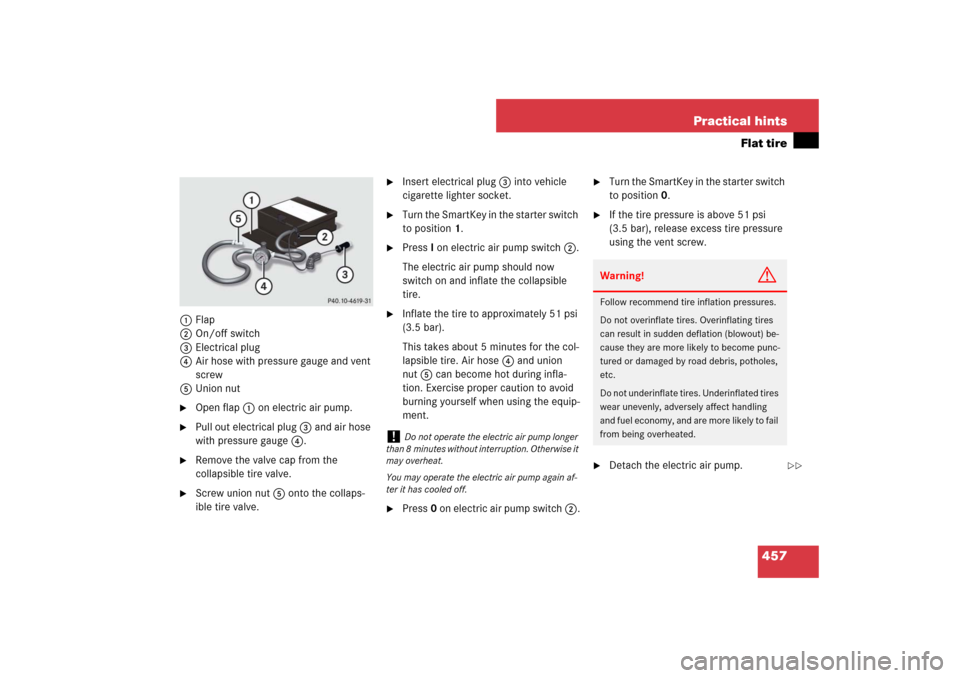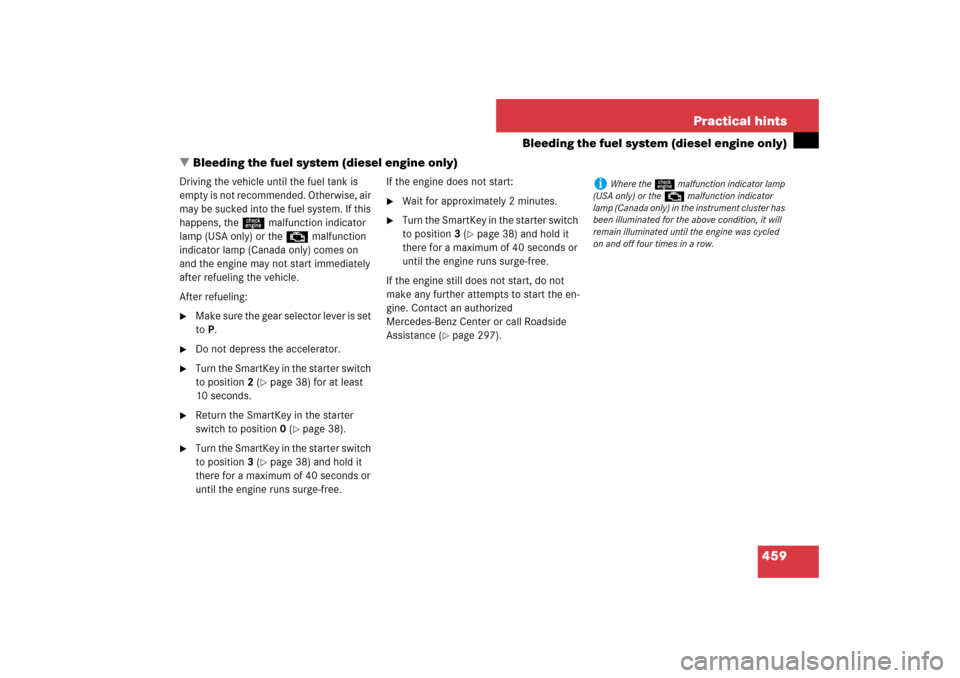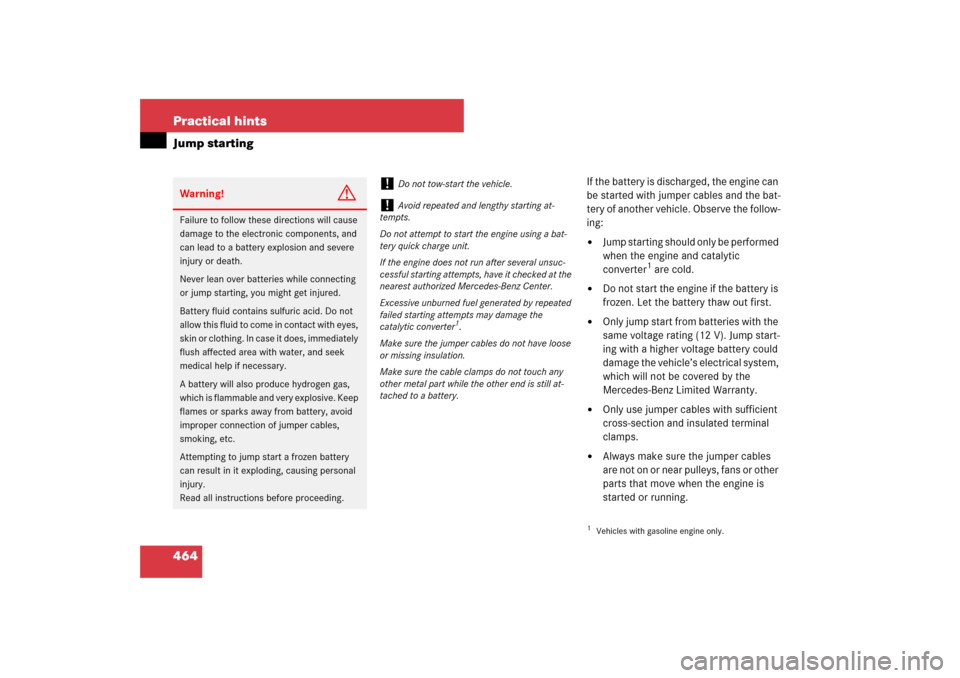Page 420 of 522
419 Practical hints
What to do if …
Display symbol
Display message
Possible cause/consequence
Possible solution
A
Reserve fuel
The fuel level has dropped below the re-
serve mark.
�
Refuel at the next gas station
(�page 321).
Gas cap is open
A loss of pressure has been detected in
the fuel system. The fuel cap may not be
closed properly or the fuel system may be
leaky.
�
Check the fuel cap (
�page 321).
If it is not closed properly:
�
Close the fuel cap.
If it is closed properly:
�
Have the fuel system checked by an au-
thorized Mercedes-Benz Center.
»
Replace air cleaner
The air cleaner is clogged.
�
Have the air cleaner checked by an au-
thorized Mercedes-Benz Center.
[
Clean fuel filter
Diesel engine:
There is water in the fuel filter.
�
Have the water drained by an autho-
rized Mercedes-Benz Center as soon as
possible.
Page 439 of 522
438 Practical hintsUnlocking/locking in an emergency�
If necessary, lock the trunk with the
mechanical key (
�page 126).
Except for the driver’s door, the vehicle
should now be locked.
�
Insert the mechanical key2 into the
driver’s door lock until it stops.
�
Turn the mechanical key2 clockwise
to position1.
The driver’s door is locked.Manually unlocking the gear selector
lever
In case of power failure, the gear selector
lever can be manually unlocked, e.g. to tow
the vehicle.
1Pin
�
Open the storage compartment in the
center armrest (
�page 285).
�
Take out the cup holder (
�page 285).
�
Insert a suitable object1 (e.g. a pin)
through the hole and press the pin
downward.
�
Remove pin1.
1
Locking
2
Mechanical key
i
This procedure does not arm the anti-theft
alarm system, nor does it lock the fuel filler flap.
i
The gear selector lever is locked again when
moving it to positionP.
��
Page 458 of 522

457 Practical hints
Flat tire
1Flap
2On/off switch
3Electrical plug
4Air hose with pressure gauge and vent
screw
5Union nut�
Open flap 1 on electric air pump.
�
Pull out electrical plug 3 and air hose
with pressure gauge 4.
�
Remove the valve cap from the
collapsible tire valve.
�
Screw union nut5 onto the collaps-
ible tire valve.
�
Insert electrical plug 3 into vehicle
cigarette lighter socket.
�
Turn the SmartKey in the starter switch
to position1.
�
PressI on electric air pump switch 2.
The electric air pump should now
switch on and inflate the collapsible
tire.
�
Inflate the tire to approximately 51 psi
(3.5 bar).
This takes about 5 minutes for the col-
lapsible tire. Air hose 4 and union
nut5 can become hot during infla-
tion. Exercise proper caution to avoid
burning yourself when using the equip-
ment.
�
Press0 on electric air pump switch 2.
�
Turn the SmartKey in the starter switch
to position0.
�
If the tire pressure is above 51 psi
(3.5 bar), release excess tire pressure
using the vent screw.
�
Detach the electric air pump.
!
Do not operate the electric air pump longer
than 8 minutes without interruption. Otherwise it
may overheat.
You may operate the electric air pump again af-
ter it has cooled off.
Warning!
G
Follow recommend tire inflation pressures.
Do not overinflate tires. Overinflating tires
can result in sudden deflation (blowout) be-
cause they are more likely to become punc-
tured or damaged by road debris, potholes,
etc.
Do not underinflate tires. Underinflated tires
wear unevenly, adversely affect handling
and fuel economy, and are more likely to fail
from being overheated.
��
Page 460 of 522

459 Practical hints
Bleeding the fuel system (diesel engine only)
�Bleeding the fuel system (diesel engine only)
Driving the vehicle until the fuel tank is
empty is not recommended. Otherwise, air
may be sucked into the fuel system. If this
happens, theú malfunction indicator
lamp (USA only) or the ±malfunction
indicator lamp (Canada only) comes on
and the engine may not start immediately
after refueling the vehicle.
After refueling:�
Make sure the gear selector lever is set
to P.
�
Do not depress the accelerator.
�
Turn the SmartKey in the starter switch
to position2 (
�page 38) for at least
10 seconds.
�
Return the SmartKey in the starter
switch to position0 (
�page 38).
�
Turn the SmartKey in the starter switch
to position3 (
�page 38) and hold it
there for a maximum of 40 seconds or
until the engine runs surge-free.If the engine does not start:
�
Wait for approximately 2 minutes.
�
Turn the SmartKey in the starter switch
to position3 (
�page 38) and hold it
there for a maximum of 40 seconds or
until the engine runs surge-free.
If the engine still does not start, do not
make any further attempts to start the en-
gine. Contact an authorized
Mercedes-Benz Center or call Roadside
Assistance (
�page 297).
i
Where theú malfunction indicator lamp
(USA only) or the± malfunction indicator
lamp (Canada only) in the instrument cluster has
been illuminated for the above condition, it will
remain illuminated until the engine was cycled
on and off four times in a row.
Page 465 of 522

464 Practical hintsJump starting
If the battery is discharged, the engine can
be started with jumper cables and the bat-
tery of another vehicle. Observe the follow-
ing:�
Jump starting should only be performed
when the engine and catalytic
converter
1 are cold.
�
Do not start the engine if the battery is
frozen. Let the battery thaw out first.
�
Only jump start from batteries with the
same voltage rating (12 V). Jump start-
ing with a higher voltage battery could
damage the vehicle’s electrical system,
which will not be covered by the
Mercedes-Benz Limited Warranty.
�
Only use jumper cables with sufficient
cross-section and insulated terminal
clamps.
�
Always make sure the jumper cables
are not on or near pulleys, fans or other
parts that move when the engine is
started or running.
Warning!
G
Failure to follow these directions will cause
damage to the electronic components, and
can lead to a battery explosion and severe
injury or death.
Never lean over batteries while connecting
or jump starting, you might get injured.
Battery fluid contains sulfuric acid. Do not
allow this fluid to come in contact with eyes,
skin or clothing. In case it does, immediately
flush affected area with water, and seek
medical help if necessary.
A battery will also produce hydrogen gas,
which is flammable and very explosive. Keep
flames or sparks away from battery, avoid
improper connection of jumper cables,
smoking, etc.
Attempting to jump start a frozen battery
can result in it exploding, causing personal
injury.
Read all instructions before proceeding.
!
Do not tow-start the vehicle.
!
Avoid repeated and lengthy starting at-
tempts.
Do not attempt to start the engine using a bat-
tery quick charge unit.
If the engine does not run after several unsuc-
cessful starting attempts, have it checked at the
nearest authorized Mercedes-Benz Center.
Excessive unburned fuel generated by repeated
failed starting attempts may damage the
catalytic converter
1.
Make sure the jumper cables do not have loose
or missing insulation.
Make sure the cable clamps do not touch any
other metal part while the other end is still at-
tached to a battery.
1Vehicles with gasoline engine only.
Page 474 of 522
473 Technical data
Parts service
Warranty coverage
Identification labels
Layout of poly-V-belt drive
Engine
Rims and tires
Electrical system
Main dimensions and weights
Fuels, coolants, lubricants etc.
Page 480 of 522

479 Technical data
Engine
�Engine
Model
E 320 BLUETEC (211.022
1)
E 350 (211.056
1)
E 350 4MATIC (211.087
1)
1The quoted data apply only to the standard vehicle. See an authorized Mercedes-Benz Center for the corresponding data of all special bodies and special equipment.Engine
OM 642
272
Mode of operation
Diesel 4-stroke
4-stroke engine, gasoline injection
No. of cylinders
6
6
Bore
3.27 in (83.00 mm)
3.66 in (92.90 mm)
Stroke
3.62 in (92.00 mm)
3.39 in (86.00 mm)
Total piston displacement
182.9 cu in (2 987 cm
3)
213.5 cu in (3 498 cm
3)
Compression ratio
16.5:1
10.7:1
Output acc. to SAE J 1349
208 hp/3 600 rpm
(155 kW/3 600 rpm)
268 hp / 6 000 rpm
2
(200 kW / 6 000 rpm)
2Premium fuel required. Performance may vary with fuel octane rating.Maximum torque acc. to SAE J 1349
398 lb-ft/1 600 rpm - 2 400 rpm
(540 Nm/1 600 rpm - 2 400 rpm)
258 lb-ft / 2 400 rpm - 5 000 rpm
(350 Nm / 2 400 rpm - 5 000 rpm)
Maximum engine speed
4 500 rpm
6 500 rpm
Firing order
1-4-2-5-3-6
1-4-3-6-2-5
Poly-V-belt
2 035 mm
2 404 mm
Page 481 of 522

480 Technical dataEngineModel
E 550 (211.072
1)
E 550 4MATIC (211.090
1)
E 63 AMG (211.077
1)
1The quoted data apply only to the standard vehicle. See an authorized Mercedes-Benz Center for the corresponding data of all special bodies and special equipment.Engine
273
156
Mode of operation
4-stroke engine, gasoline injection
4-stroke engine, gasoline injection
No. of cylinders
8
8
Bore
3.86 in (98.00 mm)
4.02 in (102.20 mm)
Stroke
3.56 in (90.50 mm)
3.72 in (94.60 mm)
Total piston displacement
333.3 cu in (5 461 cm
3)
378.8 cu in (6 208 cm
3)
Compression ratio
10.7:1
11.3:1
Output acc. to SAE J 1349
382 hp/6 000 rpm
2
(285 kW/6 000 rpm)
507 hp/6 800 rpm
2
(378 kW/6 800 rpm)
2Premium fuel required. Performance may vary with fuel octane rating.Maximum torque acc. to SAE J 1349
391 lb-ft/2 800 rpm - 4 800 rpm
(530 Nm/2 800 rpm - 4 800 rpm)
468 lb-ft/5 200 rpm
(635 Nm/5 200 rpm)
Maximum engine speed
6500 rpm
7200 rpm
Firing order
1-5-4-2-6-3-7-8
1-5-4-2-6-3-7-8
Poly-V-belt
2404 mm
2369 mm